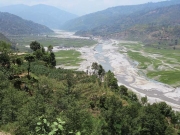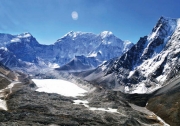Rivers
From policy to practice - Koshi river basin management
Posted on 19 Dec, 2010 10:43 PM This document titled “From Policy to Practice” is a process documentation of Water and Energy Commission Secretariat (WECS) and World Wildlife Fund’s (WWF) joint initiative for the first field piloting of Integrated Water Resource Management (IWRM) approach as prioritized by the National Water Plan 2005 in Koshi River Basin, Nepal.
This document titled “From Policy to Practice” is a process documentation of Water and Energy Commission Secretariat (WECS) and World Wildlife Fund’s (WWF) joint initiative for the first field piloting of Integrated Water Resource Management (IWRM) approach as prioritized by the National Water Plan 2005 in Koshi River Basin, Nepal.
This pictoral document explains the effort to translate policy into practice by showcasing Koshi River Basin Management Program as a model for conservation and wise use of water and its resources to secure life and livelihoods of generations to come by addressing the impacts of climate change.
Formation of glacial lakes in the Hindu Kush-Himalayas and Glacial Lake Outburst Flood risk assessment - A report by ICIMOD
Posted on 19 Dec, 2010 05:17 PM This report by ICIMOD contains an assessment of the threat facing the Hindu Kush-Himalayan region from the recent (post-1950s) and rapid formation of meltwater lakes on the surface or at the end of a large number of the region’s glaciers owing to current climate warming. Individual case studies of the catastrophic outburst (glacial lake outburst floods or GLOFs) from such glacial lakes are introduced.
This report by ICIMOD contains an assessment of the threat facing the Hindu Kush-Himalayan region from the recent (post-1950s) and rapid formation of meltwater lakes on the surface or at the end of a large number of the region’s glaciers owing to current climate warming. Individual case studies of the catastrophic outburst (glacial lake outburst floods or GLOFs) from such glacial lakes are introduced.
International Rivers is looking for Executive Director
Posted on 18 Dec, 2010 12:17 PMContent and Image Courtesy: International Rivers
International Rivers is accepting applications for the position of Executive Director. International Rivers seeks a proven, passionate, and dynamic Executive Director who has a keen sense of the urgency of the threats to rivers and communities – as well as the need for sustainable solutions – and is ready to take on this challenge with enthusiasm, strategic vision, creativity, and bold tactics.
Himalayi Jan Goshnapatra: Himalayi Niti Ka Prarup – A report in Hindi by the Gandhi Peace Foundation
Posted on 18 Dec, 2010 08:19 AMThis document in Hindi prepared by the Gandhi Peace Foundation, is a blueprint of the Himalayan People's Manifesto. The manifesto has been brought out with the help of various documents prepared by various people and organisations at different times. It will be finalised by the next Himalayan Day on September 9, 2011.
Water management across space and time in India – A working paper by the University of Bonn
Posted on 17 Dec, 2010 10:09 PMThis working paper by the University of Bonn attempts to give a spatial and temporal overview of water management in India. It traces how people and the successive regimes made choices across space and time from a wide range of water control and distribution technologies. The paper divides the water management in India into four periods –
- the traditional system of water management before colonial times;
- response from the colonial rulers to manage the complex socio-ecological system;
- large scale surface water development after independence; and
- finally, the small-scale community and market-led revolution.
Embankments related compensation to drain Indian exchequer : Need to review the flood control policy of the Government
Posted on 16 Dec, 2010 03:14 PMGovernment of Nepal has asked the Government of India to compensate its citizens badly affected by embankments and other flood control measures taken on river Gandak. Will this not lead to a flood of demands for compensation by the victims of similar problems in other river basins like the Bagmati, the Kamala and the Kosi?
Immediate moratorium sought on clearances for large dams in northeast India - Press release by Krishak Mukti Sangram Samiti (Assam)
Posted on 14 Dec, 2010 10:56 PM23rd November 2010, New Delhi
- Seeking a moratorium on clearances for large dams in Northeast India
- Withdrawal of clearances granted to 2000 MW Lower Subansiri, 1750 MW Demwe Lower & 1500 MW Tipaimukh dams
- Future steps on hydropower projects and dams only after full, prior and informed consent of people in the region
- Protect the Brahmaputra river basin as a cultural and ecological endowment
Unregulated sand mining threatens Indian rivers - Ground report article
Posted on 11 Dec, 2010 03:47 PMArticle and Image Courtesy: Ground Report
Many in India, perhaps, are not able to foresee how lack of governance, virtually, in every sphere is going to hit them in not too distant future. Take for instance mining. Illegal mining of mineral resources, with generous help of political and bureaucratic big wigs, is so rampant that not only are the country’s precious natural resources being purloined in a big way, its forests are being clean-felled, land degraded and its rivers threatened with extinction.
On the brink: Water governance in the Yamuna river basin in Haryana
Posted on 08 Dec, 2010 10:07 PMThis study attempts to develop a case study of the Western Yamuna Canal Command in Haryana with the purpose of developing a general picture of the institutional environment and arrangements related to water resource development and use in the State of Haryana. It is based on a review of water law, policy and administration and helps draw conclusions on whether the existing governance systems are meeting the current needs and suggests alternate options. The study has attempted to test the following hypothesis –
Water security for India: The external dynamics - An IDSA Task Force Report
Posted on 01 Dec, 2010 08:44 PMThe report by Institute for Defence Studies and Analyses is premised on the fact that India is facing a serious water resource problem and is expected to become 'water stressed' by 2025 and 'water scarce' by 2050. It raises fundamental questions about the forces driving water demand and the political dynamics of riparian relations, both in terms of hindrances and opportunities, amongst states in the subcontinent. Rivers, a crucial source of water resources, physically link upstream and downstream users and at the same time create barriers.




